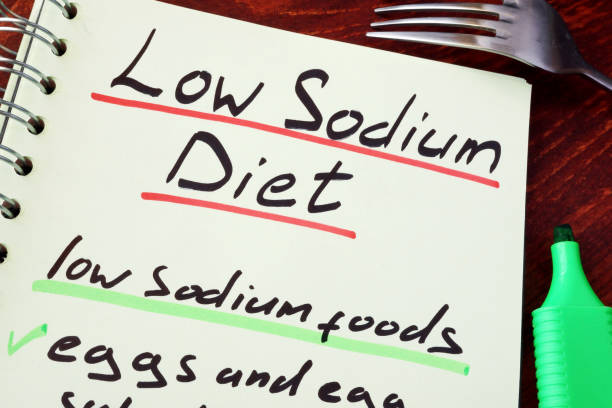Many people drink more sodium than they know, and this hidden habit may be putting their hearts and arteries under constant strain. A low sodium diet, particularly when combined with the DASH (Dietary Approaches to Stop Hypertension) diet, is a clinically established method for lowering blood pressure and protecting your cardiovascular health. Let’s look at how these diets operate, why they matter, and how you might include them into your everyday routine.
Understanding Sodium and Its Effects on the Body
Sodium is an essential mineral that plays a role in nerve function, muscle contraction, and fluid balance. But when consumed in excess—often through processed foods and restaurant meals—it can lead to fluid retention, increased blood volume, and elevated blood pressure.
Over time, this added pressure damages arteries, weakens the heart, and increases the risk of stroke, heart failure, and kidney disease.
The American Heart Association recommends limiting sodium intake to no more than 2,300 mg per day, with an ideal target of 1,500 mg per day for most adults, especially those with hypertension.
What is a Low-Sodium Diet?
It’s more than simply avoiding the salt shaker. A low sodium diet entails decreasing the total sodium level of your meals by:
- Avoid highly processed foods such as deli meats, canned soups, and salty snacks.
- Cooking fresh meals at home with herbs and spices to add taste
- Reading food labels and selecting products labeled as “low sodium” or “no added salt”
- Be aware of hidden sodium in sauces, condiments, and frozen foods.
This dietary approach can considerably lower blood pressure, especially in salt-sensitive people. It is also necessary for treating illnesses like heart failure, renal disease, and osteoporosis.
MUST READ; 7 Foods That Support Healthy Hormones
What Is the DASH Diet?
The National Institutes of Health (NIH) financed research that resulted in the development of the DASH diet. It has often been named among the greatest diets for heart health due to its emphasis on nutrient-dense, low-sodium meals. The DASH diet includes:
- Fruits and vegetables
- Whole grains (fiber, B vitamins)
- fat dairy products (calcium, protein)
- Lean proteins (chicken, fish, and lentils).
- Nuts and seeds (rich in healthful fats and magnesium)
- Limit sugars, saturated fats, and red meat.
This eating pattern naturally reduces sodium while increasing potassium, magnesium, and calcium—all of which assist regulate blood pressure.
Benefits of Combining Low Sodium and DASH Diets
- Improved Blood Pressure Control; Reducing sodium intake allows the kidneys to eliminate extra water from the blood, decreasing blood volume and pressure. When combined with potassium-rich DASH foods, the effect is much more noticeable. According to studies, those who follow a low salt DASH diet can lower their systolic blood pressure by 8 to 14 points, which is comparable to the effect of various drugs.
- Reduced risk of heart disease; The DASH diet reduces LDL (“bad”) cholesterol and promotes vascular health. Over time, this lowers the risk of heart attacks, strokes, and heart failure, particularly in persons with prehypertension or hypertension.
- Reduced kidney stone formation; A high-sodium diet can raise calcium levels in the urine, which is a risk factor for kidney stones. DASH’s emphasis on calcium and potassium while limiting sodium promotes kidney function.
- Bone Health Support; Too much sodium can cause calcium loss through urine, which weakens bones. DASH’s low-sodium, high-calcium composition helps to retain bone density, particularly in postmenopausal women.
- Weight Management; The DASH diet promotes nutrient-dense, low-calorie foods that increase satiety and keep blood sugar levels steady. While it is not a weight loss diet in and of itself, following its instructions can result in healthy weight loss for many people.
How to Start a Low Sodium DASH Diet
- Avoid processed foods: Canned soups, frozen dinners, quick noodles, and deli meats are generally high in salt. Choose fresh or low-sodium alternatives instead.
- Read the labels carefully: Look for “low sodium,” “sodium-free,” or “reduced sodium” sauces, seasonings, and packaged foods.
- Use herbs and spices: Garlic, lemon juice, rosemary, cumin, turmeric, and basil provide depth without increasing sodium levels.
- Choose potassium-rich foods: Bananas, spinach, sweet potatoes, and oranges, all of which are DASH staples, can help to manage sodium levels.
- Beware of hidden salt: Bread, cheese, breakfast cereals, and salad dressings can contain surprising quantities of sodium.
Final Thoughts: The Impact of Small Changes
The transition to a low salt, DASH-style eating plan does not need sacrificing flavor or delight in food. It’s about being more intentional—reading labels, cooking at home, and choosing nutrient-dense whole foods. The benefits go well beyond blood pressure control, including long-term protection for the heart, brain, kidneys, and bones. Begin with small, long-term improvements and let your diet become a sort of medication.


